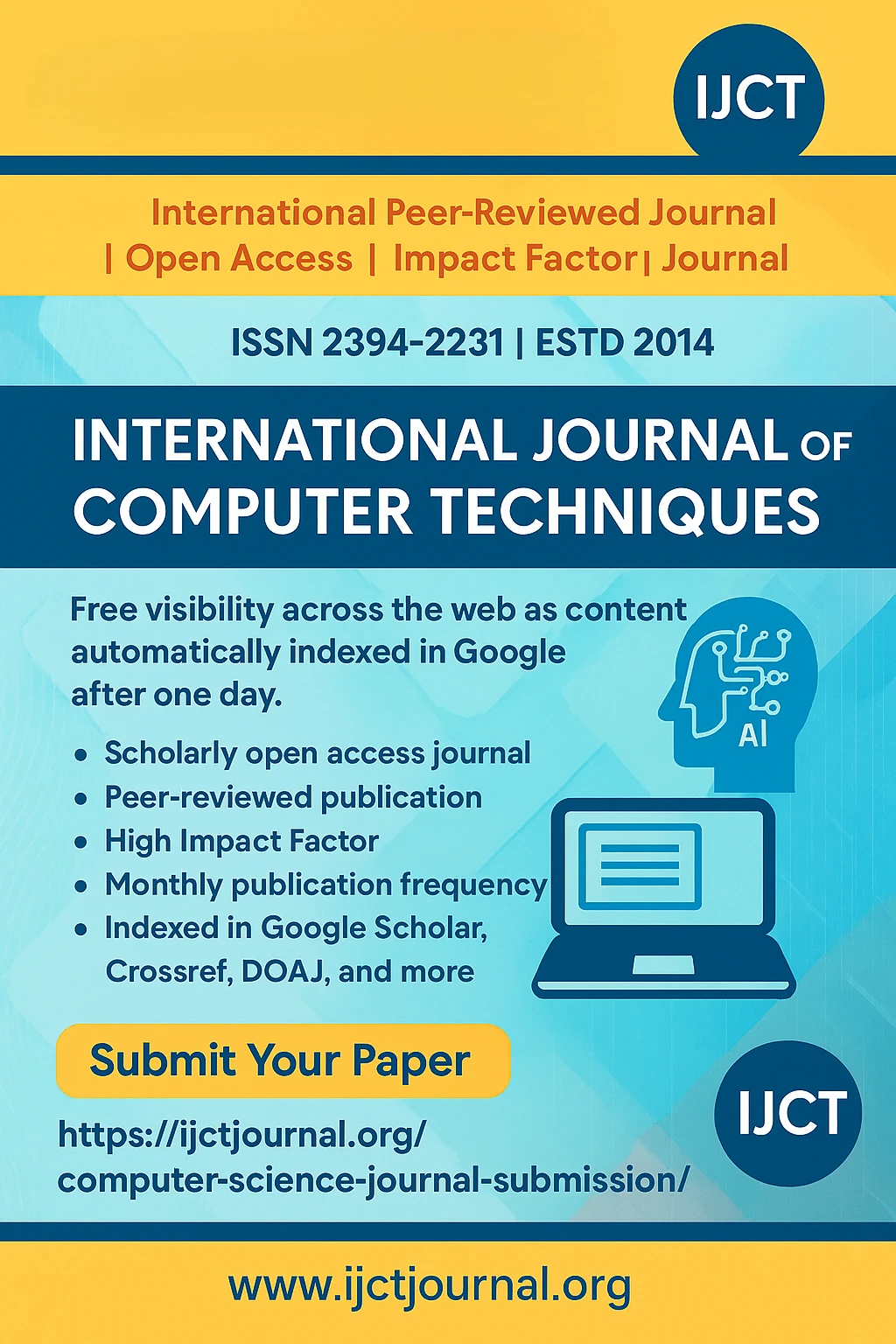
Threat Detection Performance Analysis in Industrial IoT Systems Using Hybrid Machine Learning | IJCT Volume 12 – Issue 5 | IJCT-V12I5P63

International Journal of Computer Techniques
ISSN 2394-2231
Volume 12, Issue 5 | Published: September – October 2025
Author
Boye Aziboledia Frederick, Onate Egerton Taylor, Vincent Ike Anireh, Emmanuel Okoni Bennett
Table of Contents
ToggleAbstract
The rapid integration of Industrial Internet of Things technologies has enhanced productivity and operational efficiency across critical industries such as manufacturing, energy, and transportation. However, the highly connected nature of IIoT environments has also increased their vulnerability to a wide range of cyber threats. This paper presents a comprehensive study on threat detection performance analysis in industrial IoT systems using hybrid machine learning (ML) model. The proposed approach improves anomaly detection accuracy by more 90% while minimizing false positives with an average of 2.51%. Furthermore, various performance metrics achieved include detection rate of more than 90%, precision, recall, F1-score all falls within 92.5% and latency average of 1.207µsec (0.001027ms) with corresponding to 7.14%, a result obtained during the implementation analysis to assess the effectiveness of hybrid ML model compared to other approaches. Results from performance evaluations using benchmark industrial IoT datasets from dataset indicate that the hybrid framework achieves improved detection performance, accuracy and latency (system response time). From the findings, the system latency improves and with the contextual benchmarking in industrial IoT applications. The study underscores the potential of integrating hybrid machine learning solutions into IIoT security frameworks for real-time threat mitigation.
Keywords
Industrial IoT, Threat Detection, Machine Learning, Intrusion Detection Systems (IDS), Performance Analysis, Cybersecurity, Anomaly Detection.Conclusion
The hybrid ML model represents a viable and effective solution for threat detection in industrial IoT systems, offering improved accuracy and reduced false alarms compared to conventional IDS methods. This study provides a detailed performance analysis framework, which can guide future industrial IoT security implementations. Future research will focus on optimizing hybrid ML architectures for low performance metrics for deployment of resource-constrained industrial IoT devices, integrating the hybrid machine learning approach for threat detection, and expanding evaluation to real-world industrial environments. Further research work should be considered since the system simulation was not performed under heavy workloads and multiple simultaneous attacks.
Fourteen (14) domain expert users carried the implementation between 30 to 1 hr. simulation validation to ascertain the threat detection performance capabilities of the system. The IIoT system deployment was not done directly on the life running process plant as this will affect the whole plant system configurations. The system was connected to the Instrument Lab apparatus provided for the industrial IoT systems simulation.
References
[1] Sharma, K., Soumya, B., & Brijesh, K. (2022). Intrusion Detection System in IoT Network using ML, Volume 20, Issue 13, Page 3597-3601| DOI: 10.14704/nq.2022.20.13.NQ88441, ReserachGate.
[2] Ahmed C. M, Gauthama R. M R, Aditya M. (2021). Challenges in Machine Learning based approaches for Real-Time Anomaly Detection in Industrial Control Systems, ResearchGate.
[3] Ramya, M. (2022). What Is a Man-in-the-Middle Attack? Definition, Detection, and Prevention Best Practices for 2022, www.spiceworks.com/it-security/data-security/articles/man-in-the-middle-attack/.
[4] H-ISAC, (2021). Distributed Denial of Service (DDoS), Health-ISAC, www. H-isac.org.
[5] Chika, A. (2023). Ransomware – An Overview, https://www.nomoreransom.org
[6] Lin, P., Lee, Y., & Huang, C. (2015). A Hybrid Machine Learning Approach for Intrusion Detection Using K-NN, Cluster Center, CANN, and SVM. International Journal of Network Security, 17(6), 674–683.
[7] Aziz, A.S.A. (2016). Comparison of classification techniques applied for network intrusion detection and classification. Journal of Applied Logic 24. Elsevier, 109-118.
[8] Kayvan A, S. Yahya, Amirali R. & Siti Hazyanti Binti M. H (2016). “Anomaly Detection Based on Profile Signature in Network using Machine Learning Techniques.” Presented at the 2016 IEEE Region 10 Symposium (TENSYMP), pp. 71–76.
[9] Deyban, P., Miguel, A. A., Perez, A. D. & Eugenio, S. (2017). Intrusion detection in computer networks using hybrid machine learning techniques. XLIII Latin American Computer Conference IEEE, 1-10.
[10] Vinoth, Y. & Kamatchi, K. (2020). Anomaly Based Network Intrusion Detection using Ensemble Machine Learning Technique. International Journal of Research in Engineering, Science and Management, (290-296).
[11] Usman S. M. Megha C., Aniso A. & Mandeep K., (2020). Intrusion Detection System using Machine Learning Techniques: A Review, ResearchGate.
[12] Maniriho et al. (2020). Detecting Intrusions in Computer Network Traffic with Machine Learning Approaches. International Journal of Intelligent Engineering and Systems. INASS. (433-445).
[13] Guardian Nigeria (2022). Technology, Ransomware hits 71% of Nigerian organisations, guardian.ng/technology/ransomware-hits-71-of-nigerian-organisations/.
[14] Danane, Y. & Parvat, T. (2015). Intrusion detection system using fuzzy genetic algorithm,” in Pervasive Computing (ICPC), 2015 International Conference on. IEEE, 1–5.
[15] Ramadhan, A. M. A., Wael, M. S. Y., Hashem, A., Ghilan, Al-Madhagy, T. H., Abdel-Hamid, M. E. & Ahmed, A. W. (2022). Ransomware Detection using Machine and Deep Learning Approaches. International Journal of Advanced Computer Science and Applications, 13(11).
[16] Alsaidi, R. (2021). Ransomware detection dataset (RDD) dataset. Ransomware detection dataset (RDD) dataset. [Online]. Available: Kaggle, https://www.kaggle.com/ramdhanamalsaidi/a-novel-dataset containing-405836-url, [Accessed November 28, 20. [17] Alhawi, M., Baldwin, J. & Dehghantanha, A. (2018). Leveraging machine learning techniques for windows ransomware network traffic detection. Cyber Threat Intelligence, 93- 106.
[18] Almashhadani, A. O., Kaiiali, M., Sakir S., & Philip O. (2019). A multi-classifier network-based crypto ransomware detection system: A case study of locky ransomware. IEEE Acess, 7, 47053-47067.
[19] Ghanei H., Manavi F. & Hamzeh A. (2021). A novel method for malware detection based on hardware events using deep neural networks. Journal of Computer Virology and Hacking Technology, 17(4), 319–331.
[20] Almiani, M., AbuGhazleh, B., Al-Rahayfeh, A., Atiewi, S. & Razaque, A. (2020). Deep Recurrent Neural Network for IoT Intrusion Detection System. Science Direct Simulation Model for Practical Theory, 101, 102031. [21] Jiang, K., Wang, W., Wang, A. & Wu, H. (2020). Network intrusion detection combined hybrid sampling with deep hierarchical network. IEEE Access, 8(32), 464 – 476. [22] Asad, M., Asim, M., Javed, T., Beg, M. O., Mujtaba, H. & Abbas, S. (2020). Deepdetect: detection of distributed denial of service attacks using deep learning. Ae Computer Journal, 63(7), 983–994.
[23] Susilo, B & Sari, R (2020). Intrusion Detection in IoT Networks Using Deep Learning Algorithm. Information 2020, 11, 279. [CrossRef]
[24] Djaballah, K. A, Boukhalfa, K., Ghalem, Z. & Boukerma, O. (2020). A novel approach for the detection and analysis of phishing in social networks: the case of Twitter. In 2020 Seventh International Conference on Social Networks Analysis, Management and Security.
[25] Bagaa, M., Taleb, T., Bernal, J. & Skarmeta, A (2020). A machine learning Security Framework for Iot Systems. IEEE Access, 8, 114066–114077.
[26] Homayoun, S., Dehghantanha, A., Ahmadzadeh, M., Hashemi, S., Khayami, R., Choo, K. K. & Newton, D. E. (2019). DRTHIS: Deep ransomware threat hunting and intelligence system at the fog layer. Future Generation Computer Systems, 94-104.
[27] Shanmugam, B. & Idris, N. B. (2019). Improved intrusion detection system using fuzzy logic for detecting anamoly and misuse type of attacks. In Proceeding of 2009 International Conference of Soft Computing and Pattern Recognition, 212-217.
[28] Hamamoto, A. H. Carvalho, L. F. L., Sampaio, D. H., Abrão, T. & Proença, M. L. (2018). Network anomaly detection system using genetic algorithm and fuzzy logic. Expert Systems with Applications, 92, 390-402. [30] Davies, I., Taylor, O., Anireh, V., & Bennett, E. (2024). Adaptive Hybrid Case-Based Neuro-Fuzzy Model for Intrusion Detection and Prevention for Smart Home Network.
[32] Taylor, O. E., Ezekiel, P. S., & Igiri, C. G. (2021). Anomaly based intrusion detection/prevention system using deep reinforcement learning algorithm. Int. Journal of Adv. Research in Computer and Communication Engineering, 10(1), 58-65.
[33] Boye, A.F., Taylor, E.O. and Bhagat, D., (2024). AI and Performance Capability of Cybersecurity in the Energy Industry. ISAR Journal of Science and Technology, 2(12), 29-36.
[34] Tseng A, Chen Y, Kao Y & Lin T. (2016). Deep learning for ransomware detection. IEICE Tech. Rep. 116(282), 87-92.
[35] Ferrag, M.A., Friha, O., Hamouda, D., Maglaras, L., Member, S. & Janicke, H. (2022). Edge-IIoTset: A New Comprehensive Realistic Cyber Security Dataset of IoT and IIoT Applications for Centralized and Federated Learning”. Institute of Electrical and Electronic Engineering TechRxiv conference.
Journal Covers
IJCT Important Links
© 2025 International Journal of Computer Techniques (IJCT).
Threat Detection Performance Analysis in Industrial IoT Systems Using Hybrid Machine LearningDownload
Related Posts:










